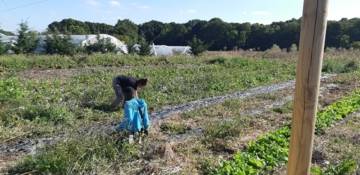We have found contents for ""
Sorry, we didn't find any results. Please ask another question.
Cette recherche n'a pas pu être traitée en raison d'un trop grand nombre de tentatives en peu de temps. Veuillez réessayer plus tard.
sur


ESDW 2020: Biodiversity in action…
Tuesday, 29 september 2020
Groupe BPCE’s action in favor of biodiversity is also reflected in the direct involvement of its companies in the management of natural areas. We provide a few examples below…
Preserving our woodland heritage
Promoting new agricultural practices that respect nature and generate employment in the local economy: this is the direction chosen by Banque Populaire Val de France within the framework of its partnership with the Arche d’Aigrefoin community, a social health-care institution.
In a former fortified farmhouse on the edge of the forest, 150 residents, including 80 mentally handicapped people, live and work on the premises.
A group of seventeen people maintain and cultivate an astonishing 7-hectare market garden. “Supported in this approach since 2019, the Arche de l’Aigrefoin has been involved over the past few weeks in a large-scale project to redevelop the landscaped area while simultaneously developing the site’s biodiversity, notably by planting melliferous trees and maintaining the marshland areas,” emphasizes the manager responsible for partnerships at Banque Populaire Val de France. And what future developments are planned? Why not become a special site officially recognized for the protection of wild birds
Environmental and ecological balance
The Caisse d’Epargne Aquitaine Poitou-Charentes, a savings bank deeply involved in the preservation of regional ecosystems, has been protecting its woodland heritage since 1957 by managing a forest reserve covering a total area of 745 hectares spread out over four PEFC* certified forests within the Landes de Gascogne Natural Park. All the forestry work undertaken – old-growth clearance, planting of new trees, cutting, the natural regeneration of the forest – is carried out in pursuit of the ecological and responsible management of the forest areas, respecting the local flora, fauna, soil and water resources.
Nearly 100 hectares were planted on the Biret massif between 2018 and 2019, notably following a forest fire in April 2018. “This is a concrete commitment by our institution to preserving the area, but also an action consistent with our bank’s desire to have a positive ecological footprint,” explains the Real Estate & General Services Director of the Caisse d’Epargne Aquitaine Poitou-Charentes.
Nature in the city
Natixis, for its part, wanted to make a direct contribution to biodiversity in the French capital by signing the Objective 100 Hectares charter with the City of Paris in 2016. The principle driving this initiative is simple: to encourage companies, public and quasi-public Parisian real-estate owners to ‘green’ 100 hectares of buildings in the capital by 2020 (green roofs, facades and walls), a third of which would be devoted to the development of urban agriculture. These goals raised a number of challenges insofar as ‘greening’ changes the aesthetics of Parisian architecture, is subject to rigorous technical standards, and may lead to additional costs for builders. In 2019, 115 hectares of buildings had already been ‘greened’**… meaning that the initial objective had largely been achieved!
* PEFC (Program for the Endorsement of Forest Certification) certifies the sustainable management of forests and unites stakeholders around a multifunctional and balanced vision of forests in 53 countries worldwide. For 20 years, PEFC France has been promoting a balance between the environmental, societal and economic dimensions of woodland through guarantees of sustainable practices and the involvement of 70,000 forest owners and more than 3,100 companies in France.
** Paris City Hall, March 2019
Reread previously published articles on actions taken by Groupe BPCE to promote biodiversity
ESDW 2020: focus on biodiversity
ESDW 2020: acting to preserve biodiversity